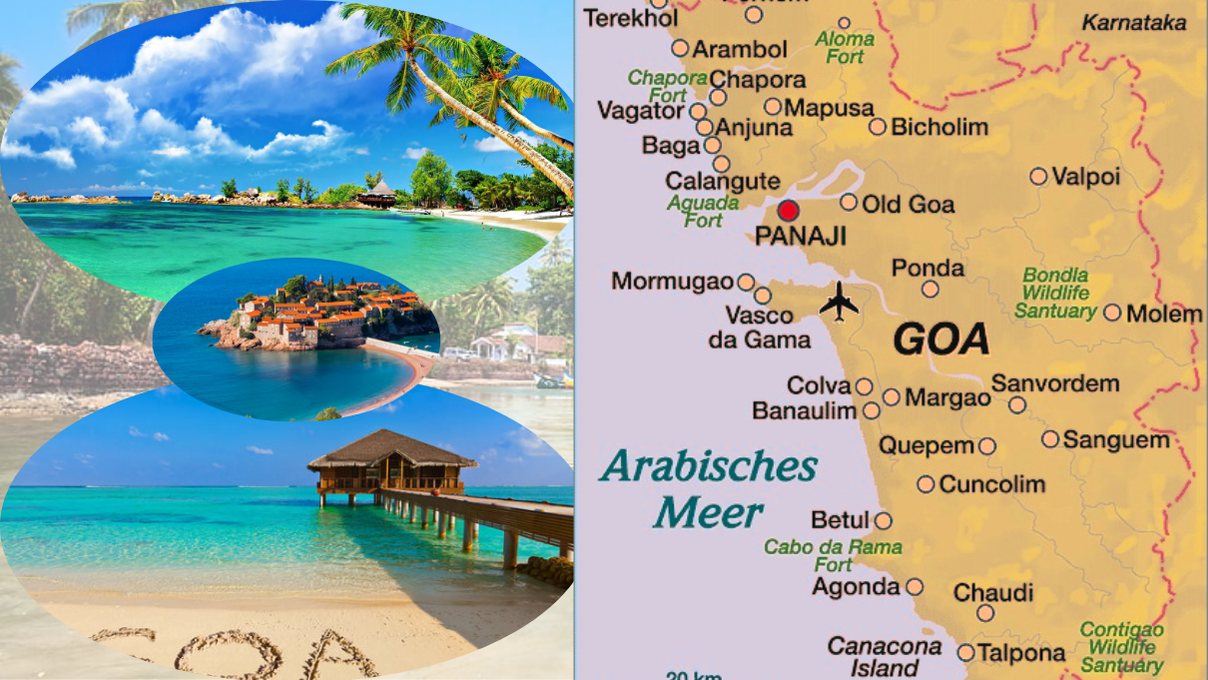Goa history
Goa is a state located on the southwestern coast of India, within the Konkan region. It is geographically distinct from the Deccan highlands by the Western Ghats, offering a unique landscape that includes coastal plains and lush hills. The state shares its borders with Maharashtra to the north, Karnataka to the east and south, while the Arabian Sea lies to its west, providing with a picturesque coastline.
As India’s smallest state by area, Goa history is also the fourth smallest by population. Despite its size, it boasts the highest GDP per capita among all Indian states, nearly two and a half times the national average. The state’s economic prosperity is reflected in its high standard of living and excellent infrastructure. The Eleventh Finance Commission of India ranked Goa as the best-placed state due to its well-developed infrastructure, while India’s National Commission on Population also rated it as having the best quality of life based on 12 key indicators. Additionally, this holds the second-highest position in India’s Human Development Index, which measures the overall well-being and quality of life of its residents.
Capital and Largest City
Panaji, located on the banks of the Mandavi River, serves as the capital of Goa history. It is known for its scenic beauty, colonial architecture, and vibrant culture. Vasco da Gama, located in the southern part of the state, is the largest city and an important commercial hub, particularly due to the presence of the Marmagao Port. Maragos, a historic city, stands as a reminder of Goa’s Portuguese colonial past and continues to showcase the influence of Portuguese culture in its architecture, festivals, and traditions.
Goa history: Geography, Economy, History, and Cultural Influence
Historical Influence
Goa history is deeply intertwined with Portuguese colonization. In the early 16th century, Portuguese explorer Afonso de Albuquerque captured the city of Goa, then part of the Bahmani-Bijapur empire, and made it the capital of the Portuguese Empire in India, known as the “Estado da India.” this remained under Portuguese rule for approximately 456 years, shaping much of its culture, architecture, and way of life. The state was annexed by India in 1961, and since then, it has developed a unique blend of Indian and Portuguese influences.
Etymology of Goa history
The exact origin of the name “Goa history ” remains unclear. Historically, the region was referred to by many names, including Goman Chala, Gopak Pattana, and Gopalapriya, among others. Ancient texts and inscriptions mention Goa by different names, with some indicating its significance as a thriving port city. After being captured by the Portuguese in 1510, the city of Goa became the capital of Portuguese India, and the name of the city eventually came to refer to the surrounding territories as well. The name Goa is believed to have derived from ancient terms and has evolved over time.
Goa’s Rich Historical Tapestry
Prehistoric Beginnings
Goa history can be traced back to ancient times with significant evidence of human life found in the form of rock engravings or petroglyphs in areas like Usgalimal and Kajur. Located within the Shimoga-Goa Greenstone Belt in the Western Ghats, these rock carvings, made on laterite platforms and granite boulders, showcase Acheulean occupation in the region. The designs depict animals, tectiforms, and circular stone structures that hint at early megalithic practices. Stone tools, such as axes and choppers, have been uncovered in regions like Kazur, Mauxim, and the Mandovi-Zuari basin, with some dating back approximately 10,000 years. These remarkable findings have recently been proposed for UNESCO World Heritage status.
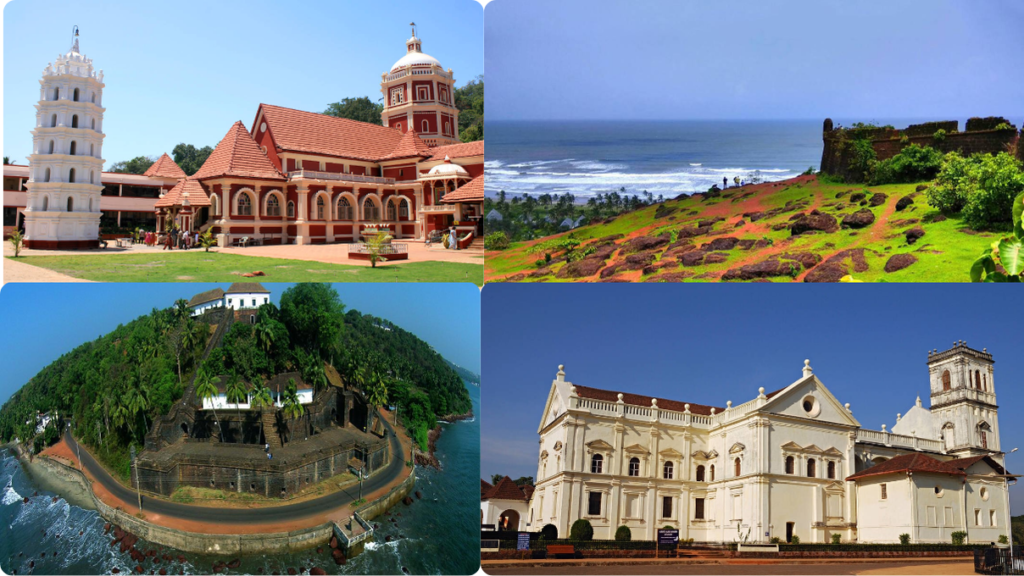
Early Societies and Cultural Amalgamation
In early times, Indo-Aryan and Dravidian migrants intermingled with Goa’s indigenous populations, forming the basis of the region’s evolving culture. these earliest societal structures were influenced by a diverse blend of traditions, which laid the foundation for its unique cultural identity.
The Ancient Dynasties of Goa history
Maurya Empire Influence
During the 3rd century BCE, Goa history became a part of the Maurya Empire under the renowned Buddhist emperor, Ashoka. Buddhist monks helped introduce Buddhism to the region, establishing a spiritual influence that would continue for centuries.
Rise of Regional Rulers and Dynasties
Between the 2nd century BCE and 6th century CE, several powerful rulers governed Goa, including the Bhojas of Goa, Chutus of Karwar, and Satavahanas of Kolhapur. From the 6th to 10th centuries, Goa history came under the control of Chalukyas of Badami, followed by the Rashtrakutas of Malkhed. This period saw a continuous feudal system where rulers like the Southern Silharas of Konkan governed as feudatories of major empires.
Kadamba Dynasty and the Patronage of Jainism
By the 10th century, the Kadamba Dynasty rose to prominence, becoming an influential ruling force in Goa history as vassals of the Chalukyas of Kalyani. The Kadambas were known for their patronage of Jainism, and they left a lasting architectural and cultural legacy.
The Arrival of Islamic Rulers
Delhi Sultanate and Vijayanagara Empire
In 1312, the Delhi Sultanate briefly established control over Goa history, although their grip on the region was weak. By 1370, Harihara I of the Vijayanagara Empire took over, marking a period of stability and growth until 1469, when Goa fell into the hands of the Bahmani Sultanate. After the fall of the Bahmanis, the Sultanate of Bijapur took control, with Velha Goa (Old Goa) emerging as a thriving capital under their rule.
The Portuguese Colonial Era
Portuguese Conquest and Settlement
In 1510, the Portuguese, led by Afonso de Albuquerque, seized Goa history from the Sultanate of Bijapur with the help of a local privateer, Thimmayya (Timoji). The establishment of a permanent settlement in Velha Goa (Old Goa) marked the start of over 450 years of Portuguese rule. The Portuguese brought significant cultural, religious, and architectural influences on the region, as seen in structures like the Se Cathedral and Basilica of Bom Jesus.
The Goa Inquisition and the Division of Territories
In 1560, the Goa Inquisition was introduced, lasting until 1812. During this period, Portuguese territories were divided into Old Conquests (Bardes, Ilhas de Goa, and Salcette) and New Conquests (Bicholim, Canacona, Pernem, Quepem, Sattari, and Sanguem) acquired throughout the 18th century. The Pinto Revolt of 1787 stands as a notable resistance against Portuguese rule, led by the elite Catholic Pintos who opposed racial discrimination.
The Legacy of New Goa (Panaji)
By 1843, the Portuguese shifted the capital from Old Goa to Cidade da Nova Goa (New Goa), now known as Panaji (Panjim). Goa history territories later became collectively known as Estado da Índia or “State of Portuguese India,” comprising Goa, Daman, and Diu.
The Modern Era: Annexation and Statehood
Indian Independence and Annexation of Goa history
After India’s independence in 1947, the Indian government urged Portugal to hand over its territories. Portugal refused, leading to the Indian Army’s Operation Vijay in 1961, which annexed Goa, Daman, and Diu into the Indian Union. This marked the end of Portuguese rule and the integration of this into India as a Union Territory.
Goa history Path to Statehood
In 1967, a historic referendum offered Goa history the choice to remain a Union Territory or merge with Maharashtra; a majority chose to maintain their identity as a Union Territory. On 30 May 1987, Goa achieved full statehood as India’s 25th state, while Daman and Diu continued as a Union Territory.
Geographical Landscape of Goa history
Overview and Location
Goa history covers an area of 3,702 square kilometers (1,429 square miles) and is located between the latitudes 14°53′54″ N and 15°40′00″ N and longitudes 73°40′33″ E and 74°20′13″ E. Positioned along the Konkan Coast, this is bordered by the Western Ghats, a range of mountains that separate it from the Deccan Plateau. The highest point in Goa is Sonsogor Peak at an altitude of 1,026 meters (3,366 feet). With a scenic coastline stretching 160 kilometers (99 miles), this is renowned for its picturesque beaches and estuaries.

Rivers and Waterways
Goa history is home to seven major rivers: the Mandovi, Zuari, Terekhol, Chapora, Galgibag, Cumbarjua canal, Talpona, and the Sal. Among these, the Mandovi and Zuari are the most prominent, connected by the Cumbarjua canal to form a vast estuarine network. These rivers, fed by the Southwest monsoon, drain around 69% of the state’s land area. They also contribute to Goa’s navigable waterways, totaling 253 kilometers (157 miles), and are among the busiest rivers in India. Goa boasts over 40 estuarine islands, eight marine islands, and 90 riverine islands.
Natural Harbors and Water Features
The Mormugao Harbor, located at the mouth of the Zuari River, is one of South Asia’s best natural harbors, providing significant commercial and fishing opportunities. Additionally, Goa history is known for its ancient water tanks (over 300) and medicinal springs (more than 100), many of which date back to the rule of the Kadamba dynasty.
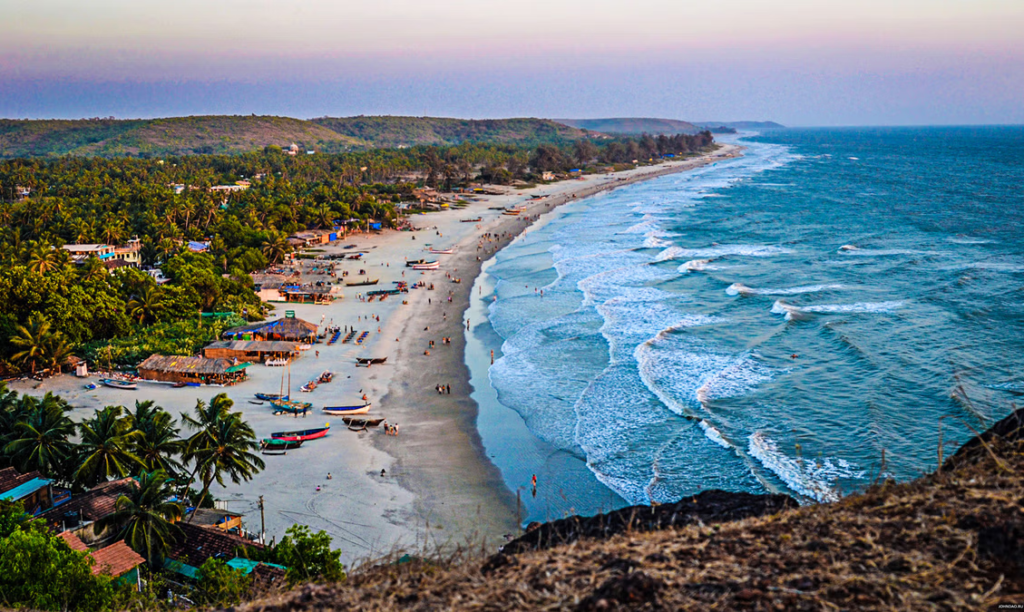
Soil and Mineral Riches
Most of Goa history soil is composed of laterites, which are rich in ferric-aluminum oxides and have a reddish hue. The riverbanks and inland areas have a mix of alluvial and loamy soils that are fertile and high in minerals, making them suitable for agriculture. Goa also has some of the oldest rocks in the Indian subcontinent between Molem and Anmod along the Karnataka border. These rocks, classified as Trondhjemitic Gneiss, are estimated to be about 3,600 million years old and serve as a significant geological landmark, with a specimen exhibited at Goa University.

The Iconic Dudhsagar Falls
One of Goa’s most stunning natural landmarks, Dudhsagar Falls, is located within the Bhagwan Mahaveer Sanctuary and Mollem National Park. This four-tiered waterfall is a popular destination, especially during the monsoon, when it flows at its most powerful, creating a spectacular sight as it cascades down the mountainside.
Climate and Seasons
Goa history experiences a tropical monsoon climate under the Köppen classification due to its proximity to the Arabian Sea. The climate is hot and humid for much of the year, with May being the hottest month, often recording daytime temperatures above 35 °C (95 °F). The year is divided into three main seasons:
- Southwest Monsoon (June to September) – Goa receives over 90% of its annual rainfall during this season, averaging around 3,048 millimeters (120 inches).
- Post-Monsoon (October to January) – Cooler and drier, with a decrease in humidity and comfortable temperatures.
- Pre-Monsoon (February to May) – A gradual increase in temperature leading to peak summer in May.
Climate Data Overview for Goa history
Temperature Patterns
- Mean Daily Maximum Temperature: Ranges from 28.8°C (83.8°F) in August to 33.0°C (91.4°F) in April and May. The hottest months are typically April and May, with temperatures reaching 33.0°C (91.4°F).
- Daily Mean Temperature: Stays relatively warm throughout the year, ranging from 26.0°C (78.8°F) in January to 30.0°C (86.0°F) in May.
- Mean Daily Minimum Temperature: The coolest nights are in January (19.6°C / 67.3°F), while May has the warmest nights with a minimum of 26.3°C (79.3°F).
Precipitation and Rainfall
- Dry Season: January through March is virtually rain-free, with only 0.2 mm (0.01 inches) of rainfall in January and 0.1 mm (0.00 inches) in February.
- Monsoon Season: Heavy rains arrive in June, peaking in July with an average of 994.8 mm (39.17 inches) of rainfall. This period has the highest number of rainy days and contributes to 90.1 precipitation days per year.
- Total Annual Rainfall: Goa receives about 2,926 mm (115.2 inches) of precipitation annually, with the majority falling between June and September.
Sunshine Hours
- Sunniest Months: January (313.1 hours) and December (300.7 hours) are the sunniest months.
- Monsoon Months: June and July see the least sunshine, with 126.0 hours and 105.4 hours, respectively.
- Total Annual Sunshine: Goa enjoys approximately 2,834.9 hours of sunshine per year, ensuring bright and sunny conditions outside the monsoon period
Administrative Subdivisions of Goa
Goa history is organized into two main districts: North Goa and South Goa, each governed by a District Collector appointed by the Indian government.

1. North Goa
- District Headquarters: Panaji (Panjim), which also serves as the capital of Goa.
- Subdivisions: Three primary subdivisions—Panaji, Mapusa, and Bicholim.
- Talukas (Subdistricts): Five talukas, which include:
- Tiswadi (Panaji)
- Bardez (Mapusa)
- Pernem
- Bicholim
- Sattari (Valpoi)
2. South Goa
- District Headquarters: Margao (Madgaon), also known as the cultural and commercial hub of Goa.
- Subdivisions: Five primary subdivisions—Ponda, Mormugao-Vasco, Margao, Quepem, and Dharbandora.
- Talukas (Subdistricts): Seven talukas, including:
- Ponda
- Mormugao
- Salcete (Margao)
- Quepem
- Canacona (Chaudi)
- Sanguem
- Dharbandora
Major Cities and Municipalities in Goa
- Goa’s major cities include Panaji, Margao, Vasco-Mormugao, Mapusa, Ponda, Bicholim, and Valpoi.
- Panaji (Panjim) is the only Municipal Corporation in Goa.
- Thirteen Municipal Councils oversee other urban areas, including Margao, Mormugao (merged with Vasco), Mapusa, Bicholim, Ponda, Quepem, and others.
- Villages: Goa has a total of 334 villages across its two districts.

Government and Politics of Goa history
Historical and Political Background
Goa history politics are distinct due to its 450-year history under Portuguese rule, compared to the British rule experienced by the rest of India. This has led to unique political dynamics in the state:
- In the early years post-integration with India, the Indian National Congress (INC) struggled to gain traction.
- Regional parties like the Maharashtrawadi Gomantak Party and the United Goans Party were more influential during the first two decades.
Administrative Structure of Goa history
- Lok Sabha Representation: Goa has two Members of Parliament (MPs) in the Lok Sabha (House of the People), representing both districts.
- Rajya Sabha Representation: The state has one MP in the Rajya Sabha (Council of the States).
- Capital: Panaji (Panjim), located on the Mandovi River’s left bank, serves as the administrative capital.
- Goa Legislative Assembly: The unicameral legislature consists of 40 members, headed by a Speaker. The assembly’s seat is located in Porvorim, across from Panaji.
Judiciary
Goa history judiciary is headed by the Goa Bench of the Bombay High Court in Panaji. Additionally, Goa follows the Portuguese Civil Code, a uniform civil code based on the Napoleonic code, making it unique in India where personal laws for different religions are common.
Executive Leadership
- Chief Minister: Leads the state government, usually representing the party or coalition with a legislative majority.
- Governor: Appointed by the President of India, the Governor is the formal head of the state.
Political Landscape and Instability
- Goa enjoyed stable governance from its incorporation into India until the 1990s.
- From 1990 to 2005, Goa experienced political instability, with 14 different governments in 15 years.
- President’s Rule was imposed in March 2005 following a period of severe political unrest, and legislative activities were temporarily suspended.
- 2005 By-Elections: The INC returned to power by winning three out of five seats.
Recent Political Developments
- 2007 Assembly Elections: The INC-led coalition emerged victorious and governed Goa history.
- 2012 Vidhan Sabha Elections: The BJP formed a coalition with the Maharashtrawadi Gomantak Party (MGP), with Manohar Parrikar as Chief Minister.
- 2017 Assembly Elections: The INC won the most seats, but no single party secured a majority. The BJP, under the leadership of Manohar Parrikar, was invited to form the government. Despite objections and legal challenges, the BJP proved its majority in a Supreme Court-mandated floor test.
Flora and Fauna of Goa history
Forest and Biodiversity
Goa history has a significant forest cover of about 1,500 km² (579 sq mi), with 1,300 km² (502 sq mi) being government-owned and 200 km² (77 sq mi) privately owned. Most forests are situated in the eastern part of the state, aligning with the Western Ghats, recognized as one of the world’s biodiversity hotspots. Due to this unique geography, National Geographic has compared Goa’s biodiversity with that of the Amazon and Congo regions.
Wildlife Diversity
Goa’s rich ecosystems include:
- Plants: Over 1,512 species
- Birds: Over 275 species
- Mammals: Over 48 species
- Reptiles: Over 60 genera
Additionally, Nanda Lake holds the title as Goa history only Ramsar wetland site.
Flora and Agriculture
The coconut palm is a familiar sight across Goa history. Its reclassification as a “palm” by the government has allowed for easier land clearance for farming and development. Rice remains the primary food crop, with pulses, ragi (finger millet), and other staples also cultivated. Cash crops include coconut, arecanut, cashew nut, and sugarcane, along with fruit crops like banana, mango, and pineapple.
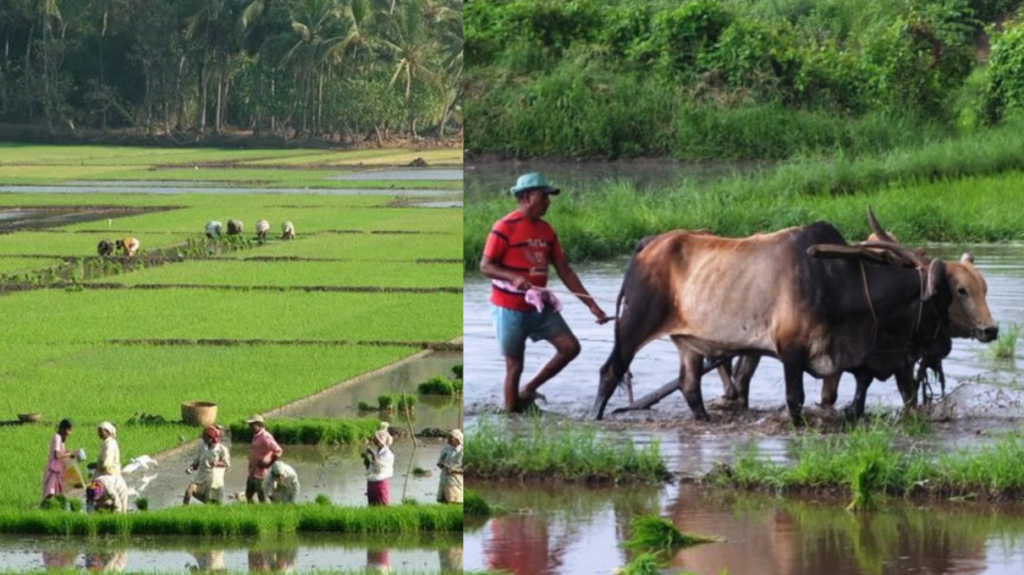
Goa history state symbols include:
- State Animal: Gaur (Indian bison)
- State Bird: Flame-throated Bulbul
- State Tree: Indian Laurel
The forests are home to a variety of trees, including teak, Sal, cashew, and mango, as well as medicinal plants.
Wildlife Sanctuaries and National Parks
Goa has a robust protected area network, covering 33% of its land area, with 62% of it designated as wildlife sanctuaries or national parks. Some of the notable ones include:
- Salim Ali Bird Sanctuary on Chorão Island, known for its avian diversity.
- Other sanctuaries: Bondla, Molem, Cotigao, Mhadei, Netravali, and Mahaveer Wildlife Sanctuary.
In addition to a diverse bird population featuring kingfishers, mynas, and parrots, Goa’s coastal and inland waters host various marine life, including crab, lobster, shrimp, jellyfish, and oysters.

Unique Ecosystem
Goa’s forests and agricultural lands contribute to a 56.6% total forest and tree cover of its geographical area. This combination of rich marine life, diverse flora, and protected wildlife areas makes Goa history a unique ecological region with vibrant natural resources.
Economy of Goa history
Goa is one of India’s wealthiest and most economically prosperous states, with a rapidly growing economy and the highest Gross State Domestic Product (GSDP) per capita in the country. In 2017, the state’s GSDP was estimated at $11 billion at current prices, reflecting its significant economic development over the decades.
Key Economic Sectors
- Tourism Tourism is the backbone of Goa history economy, contributing 12% of India’s foreign tourist arrivals. The state enjoys two peak tourist seasons:
- Winter (November to March): Attracts international tourists, mainly from Europe.
- Summer (May to August): Domestic tourists visit during this period, which coincides with Goa’s monsoon season.
The state’s scenic beaches, vibrant culture, and laid-back lifestyle make it a prime tourist destination. This influx of visitors sustains several sectors, including hospitality, transport, and retail.
- Mining Mining is Goa’s second-largest industry, thanks to its rich mineral resources. Iron ore, bauxite, manganese, and silica are among the key minerals mined in the region. Goa’s Mormugao Port plays a crucial role, handling significant iron ore exports. In 2007, it handled 39% of India’s iron ore exports. Major mining corporations like Sesa Goa (now owned by Vedanta Resources) and Dempo lead the sector.
However, unsustainable mining practices have raised concerns, with the depletion of forest cover and health risks to local communities. Illegal mining operations also persist in some areas.
- Agriculture Although agriculture’s contribution to Goa history economy has declined in recent years, it still provides part-time employment to a significant portion of the population. Rice remains the main crop, with areca nut, cashew, and coconut also cultivated. Fishing, employing around 40,000 people, is another important sector, though mechanized trawling has affected traditional methods, leading to a decline in fish catches.
- Manufacturing Goa has a diversified manufacturing base, with medium-scale industries producing goods such as pesticides, fertilizers, tires, footwear, chemicals, pharmaceuticals, steel products, and processed food (including fish and cashew nuts). This industrial diversity helps sustain the state’s economy beyond traditional sectors.
- Special Economic Zones (SEZs) Goa has 16 planned Special Economic Zones (SEZs), although further expansion has been halted due to political and public opposition. These zones aim to attract investment and boost export-oriented industries. However, their growth has faced resistance, particularly from the Goa history Catholic Church and political parties concerned about environmental degradation and land use.
Other Economic Drivers
- Remittances: Goa has one of the highest levels of remittances from its citizens working abroad, contributing significantly to the state’s economy.
- Alcohol Industry: Goa benefits from low excise duties on alcohol, making it a major revenue source for the state. This has helped maintain affordable prices for beer, wine, and spirits.
- Gambling: Goa became the first state in India to legalize gambling in 1976, which has contributed to the state’s tax revenue. In 2018-2019, casino taxes reached ₹414 crore.
Infrastructure and Development
Goa boasts a well-developed telecommunication network, with the 100% automatic telephone system, and enjoys 100% rural electrification—a significant achievement. As of 2017, the state’s installed power generation capacity stood at 547.88 MW.
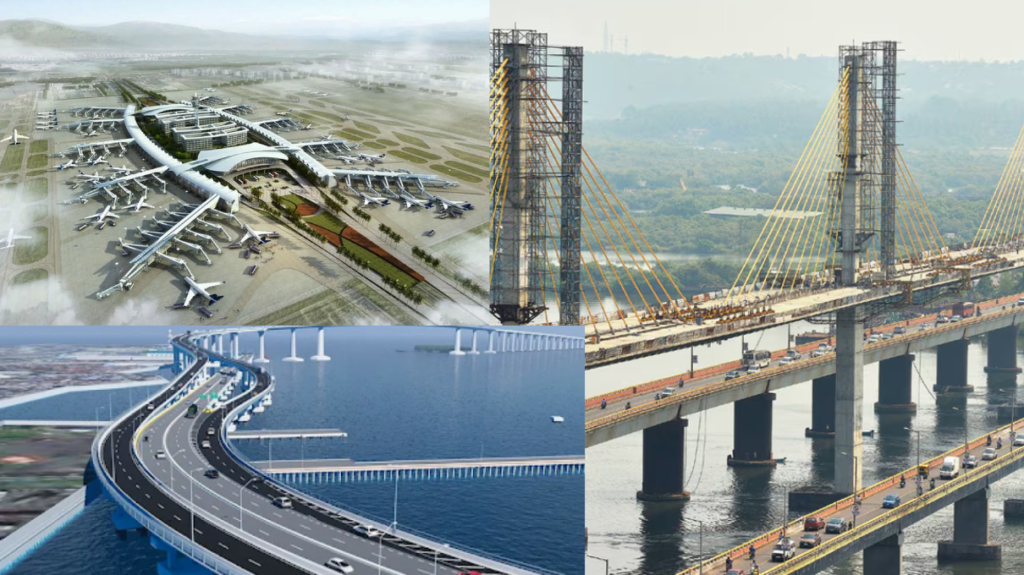
In terms of economic growth, Goa history is a model for high-income states, benefiting from strong domestic consumption, a booming tourism sector, and mining exports. However, challenges remain, particularly around environmental sustainability and maintaining a balance between development and preservation of natural resources.
Demographics of Goa
Goa, with a population of approximately 1.46 million residents as of the 2011 census, is one of the smallest states in India by population. It ranks as the fourth least populated state, following Sikkim, Mizoram, and Arunachal Pradesh. Despite its small size, Goa has a high population density of 394 people per square kilometer, surpassing the national average of 382 people per square kilometer. The state’s population is also characterized by a relatively high proportion of urban residents, with 62.17% of people living in urban areas, making it the state with the highest urban population proportion in India.
Population Growth
Goa has experienced steady population growth over the years. From 475,513 in 1901, the population steadily increased, reaching 1,458,545 by 2011. The population growth rate has fluctuated over the decades, with periods of rapid growth, particularly during the latter half of the 20th century:
- 1901: 475,513
- 1981: 1,007,749
- 2001: 1,347,668
- 2011: 1,458,545
This growth is partly due to migration from neighboring states like Karnataka and Maharashtra, which has significantly shaped the demographic composition of the state. Over 50% of the permanent population in Goa is of non-Goan origin, outnumbering the native Goan population.
Languages
The primary language spoken in Goa is Konkani, which is spoken by about 66.1% of the population as their first language. Konkani holds the status of the official language of Goa, as established by the Official Language Act of 1987. However, there have been calls for official status to be granted to Konkani in the Roman script in addition to the Devanagari script.
Other languages spoken in Goa include:
- Marathi: 10.89%
- Hindi: 8.64%
- Kannada: 4.65%
- Urdu: 2.83%
- Portuguese: 1% (though its use has declined since Goa’s integration into India)
Historically, Goa has seen a diversity of languages, influenced by various dynasties and colonial powers. Under the Kadambas (c. 960–1310), Kannada was the official language, and during the periods of Muslim rule, languages such as Persian and Kannada were prominent.
Religion
Goa is known for its religious diversity, with Hinduism being the predominant religion, followed by Christianity and Islam. According to the 2011 census, the religious distribution was:
- Hinduism: 66.1%
- Christianity: 25.1%
- Islam: 8.3%
- Sikhism: 0.1%
- Other or No Religion: 0.39%
Historically, Goa was a stronghold of Catholicism due to Portuguese colonization, with Catholics making up the majority of the population for centuries. However, over time, the percentage of Catholics in the state has declined, particularly due to emigration to other parts of India and abroad, as well as the influx of migrants from other regions. By 2021, ethnic Goans represented less than 50% of the state’s population.
The Catholic community in Goa is served by the Metropolitan Roman Catholic Archdiocese of Goa and Daman, which holds the title of the Patriarchate of the East Indies.
Goan Identity and Migration
A significant aspect of Goa’s demographic makeup is the migration patterns. A large portion of Goa’s population has moved abroad, particularly to Portugal, the United Kingdom, and Middle Eastern countries for work. These migrants continue to play an important role in supporting the state’s economy through remittances. This migration, combined with the movement of people from other parts of India, has contributed to a diverse and multicultural society in Goa.
Goa is one of India’s top tourist destinations, offering a blend of natural beauty, cultural heritage, and a lively atmosphere. The state’s appeal largely comes from its stunning beaches, vibrant nightlife, historical landmarks, and unique Portuguese influence, making it a must-visit for both Indian and international tourists.
Beaches and Water Sports
Goa’s coastline, stretching for about 103 kilometers, is home to some of the world’s most beautiful beaches. These beaches are not only picturesque but also offer a wide variety of water sports such as jet-skiing, parasailing, banana boat rides, and water scooter rides. Popular beaches like Baga, Calangute, and Anjuna are known for their lively atmosphere, while beaches like Patnem and Palolem offer more serene, laid-back experiences. These beaches are often the main reason tourists flock to Goa, and they also serve as hotspots for beach parties, making Goa a go-to destination for those seeking fun in the sun.
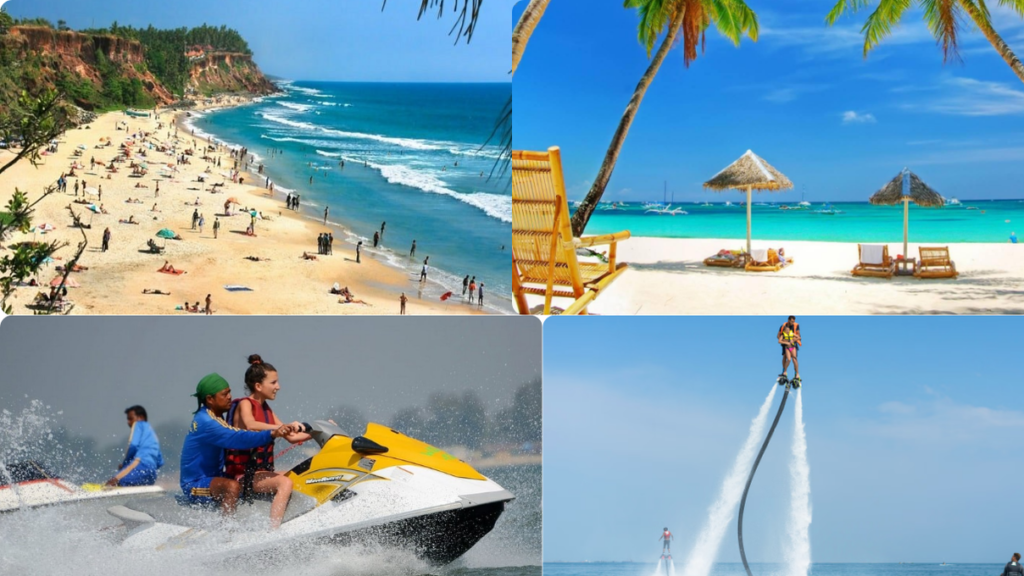
Historic Sites and Cultural Landmarks
Goa’s cultural landscape is shaped by its over 450 years of Portuguese colonial rule, which has left an indelible mark on the state’s architecture, food, and traditions. One of Goa’s most significant historical sites is the Bom Jesus Basilica, a UNESCO World Heritage Site, famous for housing the mortal remains of St. Francis Xavier. Another notable site is the Church of Our Lady of the Immaculate Conception in Panaji, which reflects Goa’s rich Catholic history.
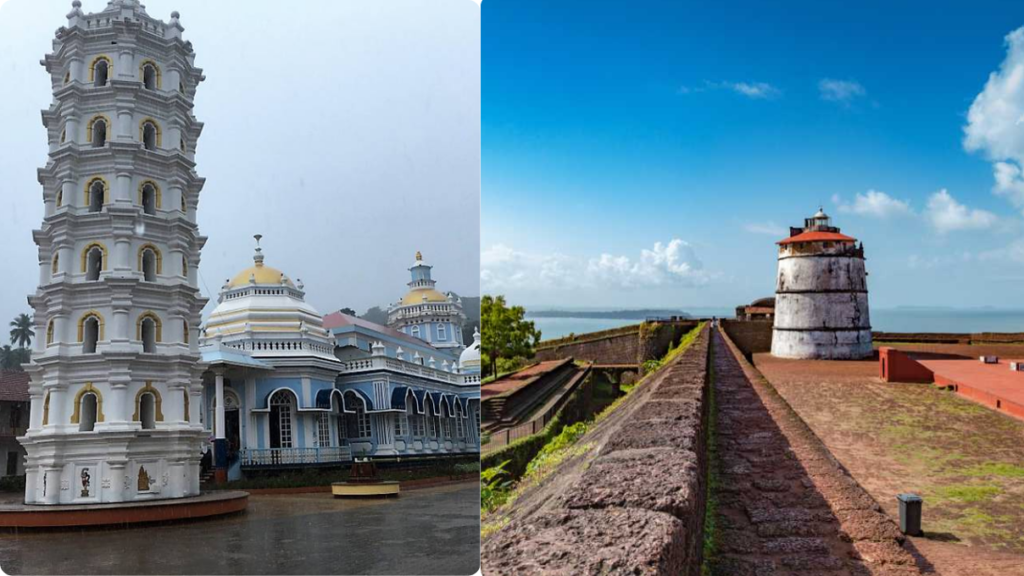
Apart from churches, Goa boasts several forts such as Fort Aguada, Chapora Fort, and Reis Magos Fort, which offer stunning views of the Arabian Sea and showcase Goa’s historical significance as a Portuguese naval base.
Cultural Heritage and Festivals
Goan culture is an eclectic blend of indigenous traditions and Portuguese influences. The state’s festivals are a true reflection of this fusion. Goa’s Carnival, held annually before Lent, is one of the largest and most colorful celebrations in the region, attracting thousands of tourists. Other major festivals include Christmas, Diwali, Shigmo, and Gomantak Vibhushan, the latter being a state award recognizing contribution to Goan culture.
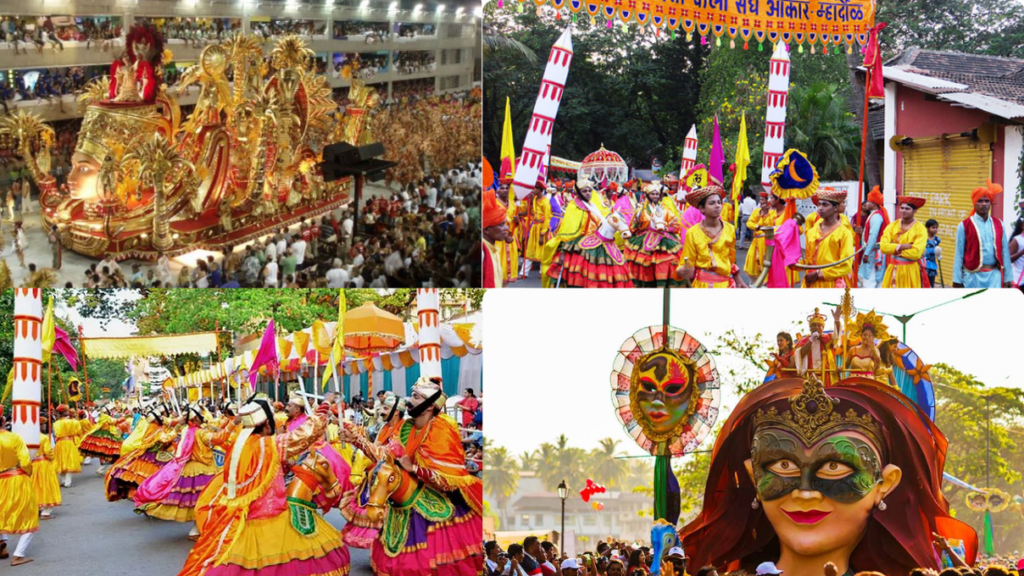
Traditional Goan music and dance also play an important role in the state’s cultural identity. Folk dances like Dekhnni, Fugdi, and Corridinho are regularly performed during festivals, while the Tiatr, a form of Konkani musical theater, remains immensely popular among Goans. These performances are often held in the Roman script of Konkani and deal with social issues, keeping the language and music alive within the community.
Museums and Education
Goa also offers cultural experiences beyond its beaches. The Goa State Museum and Naval Aviation Museum offer insights into the state’s history, art, and naval legacy. The National Institute of Oceanography in Dona Paula is another educational institution that highlights Goa’s rich maritime heritage. The Museum of Goa, a contemporary art gallery, showcases modern Goan art, and the Goa Science Centre in Miramar engages visitors with exhibits related to science and technology.

Ecotourism and Natural Beauty
In addition to its beaches, Goa’s inland areas are home to lush landscapes, rivers, and forests, making it an excellent destination for eco-tourism. The state’s wildlife sanctuaries such as Salim Ali Bird Sanctuary and Mollem National Park offer visitors the chance to explore the diverse flora and fauna of the region. The Western Ghats, a UNESCO World Heritage Site, also pass through Goa, providing opportunities for trekking, birdwatching, and nature walks.
Nightlife
Goa’s nightlife is famous worldwide, with the state consistently ranking among the top nightlife destinations in the world. Bars, nightclubs, and beach parties dot the coast, particularly in areas like Baga, Anjuna, and Vagator. Whether it’s dancing to international DJs at one of the many beach clubs or relaxing with a cocktail by the sea, Goa’s nightlife offers something for everyone. The state’s vibrant clubbing scene, combined with its laid-back beach vibe, makes it unique compared to other tourist destinations.
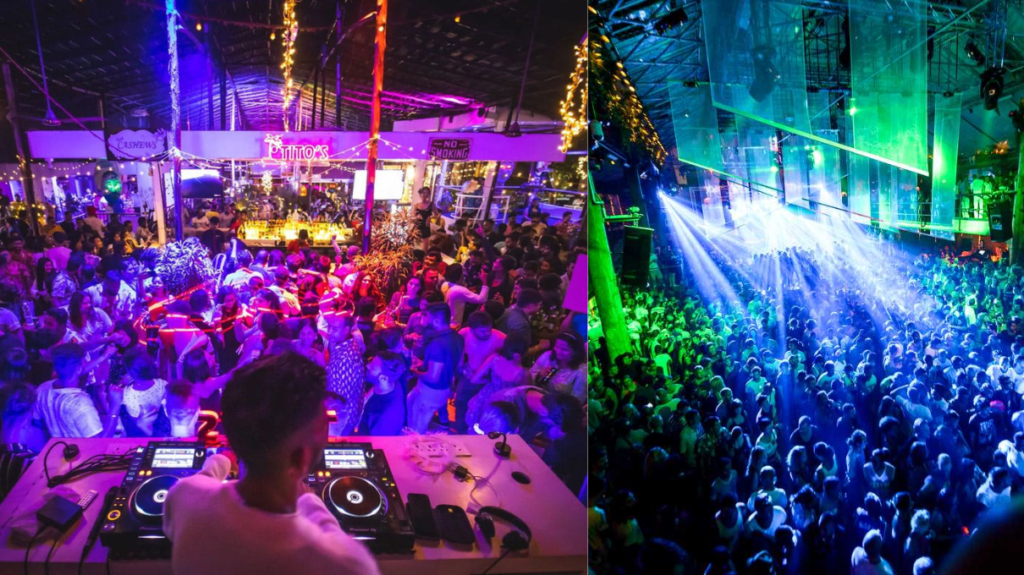
Konkani Cinema
Konkani cinema is a thriving industry within Indian cinema, where films are produced in the Konkani language, predominantly spoken in the states of Goa, Maharashtra, Karnataka, and parts of Kerala. It emerged with the release of Mogacho Anvddo on 24th April 1950, directed by A. L. Jerry Braganza. This day is celebrated as Konkani Film Day. The genre of Konkani films includes dramas, comedies, and social stories, often reflecting the cultural and social milieu of Goan society.

Goa, being a hub for film culture, hosts the International Film Festival of India (IFFI), which has been held annually since 2004. The festival attracts filmmakers, actors, and cinephiles from across the world, creating a platform to showcase both Indian and international cinema. In 2009, Paltadcho Manis (translated as The Man of the Turning Point) received international acclaim by being featured in the “World’s Best Films of 2009.”
The most commercially successful Konkani film as of 2011 was O Maria directed by Rajendra Talak, and in 2012, The Victim directed by Milroy Goes marked a significant shift in the industry with the introduction of digital theatrical films. These films help elevate Konkani cinema’s reach beyond regional audiences.
Goan Cuisine
Goan cuisine is an integral part of Goa’s cultural identity, blending both Portuguese and Indian flavors. The staple diet of Goa includes rice and fish curry, known locally as xit koddi in Konkani. Goan dishes are famous for their rich, aromatic flavors, particularly those featuring seafood, such as Goan prawn curry, vindaloo, and sorpotel.
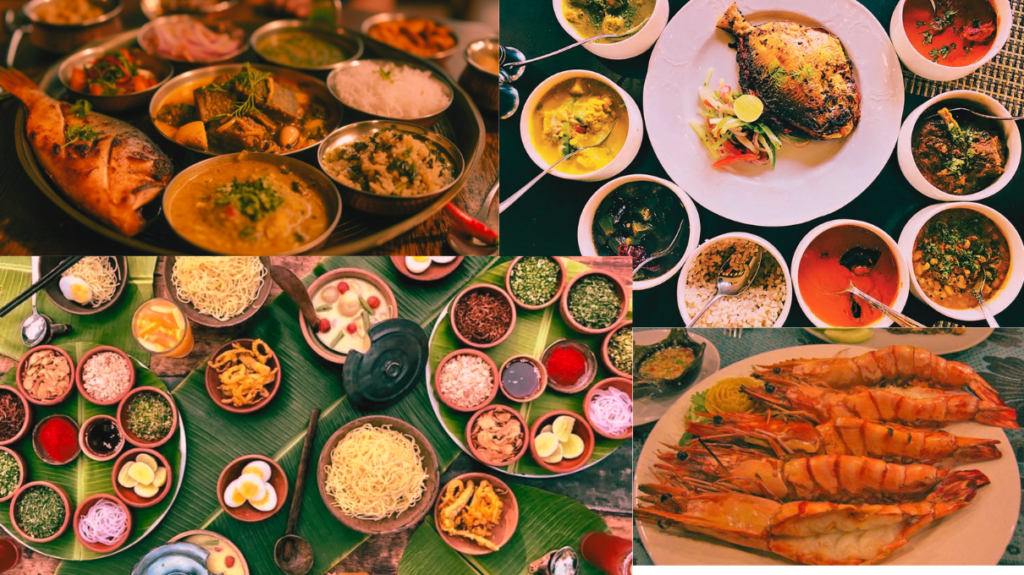
Pork-based dishes, such as vindalho, xacuti, and chouriço, are commonly prepared for festive occasions among the Goan Catholic community. Goan cuisine is also marked by the use of coconut, which imparts a distinct flavor to the dishes. Vegetarian Goan dishes, such as khatkhate (a vegetable stew with five different vegetables), are also widely consumed.
The Goan love for alcohol is reflected in their popular local drinks, especially feni, which comes in two varieties: cashew feni and coconut feni. Both are distilled liquors, with cashew feni made from fermented cashew fruit and coconut feni from toddy palm sap. Goans also enjoy wine, a legacy of Portuguese influence.
Architecture of Goa
Goa’s architecture is a beautiful amalgamation of indigenous Goan, Portuguese, and Islamic influences, with a heavy emphasis on the latter due to its 450-year colonial history under Portuguese rule. Churches, mansions, and temples in Goa showcase the fusion of these architectural styles.
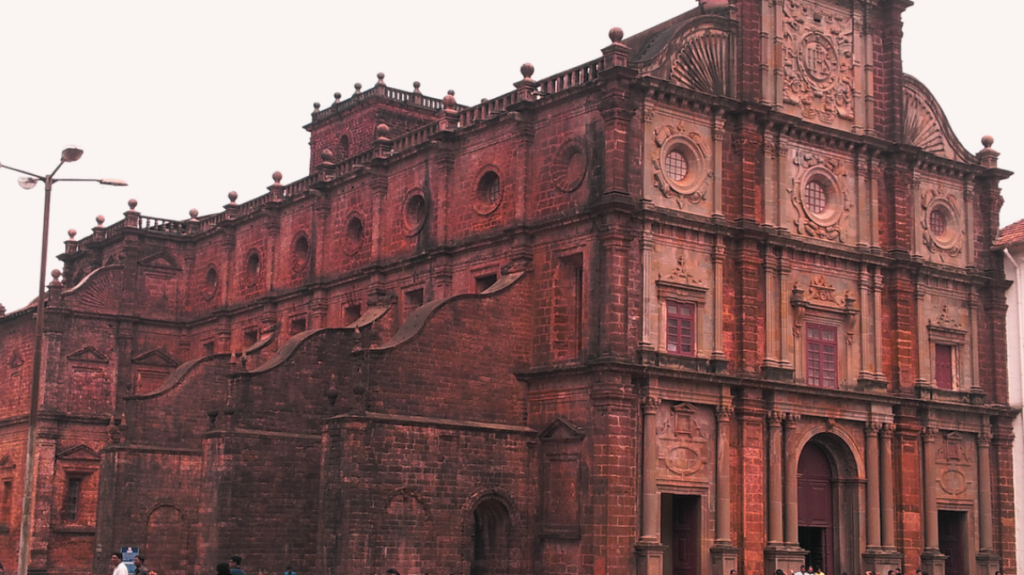
One of the iconic examples is the Bom Jesus Basilica, a UNESCO World Heritage Site, which houses the relics of St. Francis Xavier. The temples in Goa, including Shanta Durga and Mangueshi, also show the impact of Portuguese architecture, though most of them were reconstructed in the indigenous Indian style after Goa’s liberation in 1961.
Goa’s coastal cities, such as Panaji, are known for their narrow, colorful streets lined with Portuguese-style homes. The House of the Seven Gables in Margao is a prominent example of the hybrid architectural styles found across the state.
Media and Communication
Goa’s media landscape is diverse, with a combination of national and regional outlets. The state is served by cable TV, satellite channels, and a wide array of radio stations. National broadcasters, including Doordarshan, offer a variety of programming, while private channels like Big FM and Radio Indigo cater to the local audience.
Goa is also home to several prominent newspapers, such as O Heraldo (Goa’s oldest newspaper, once published in Portuguese), The Gomantak Times, and The Navhind Times, providing readers with news from both Goa and international events. Several other regional and niche publications, such as Vauraddeancho Ixtt and Bhaangar Bhuin, cater to the Konkani-speaking population.
The state also boasts a unique radio station operated by St Xavier’s College, called Voice of Xavier’s, the first community radio station in Goa.
Notable People of Goa
Goa has produced notable figures across various fields, including arts, literature, politics, and sports. Writers, such as the renowned poet and novelist Manohar Bhatkar, and musicians like renowned classical singer Mogubai Kurdikar, have contributed significantly to Goan and Indian culture. Goa is also home to politicians, military personnel, and activists who have left a lasting impact on the state and the country.
The state has also produced several world-class athletes, engineers, and scientists, including those who have excelled in the field of medicine, education, and public service.
Sports in Goa
Goa’s sports culture is unique in India, heavily influenced by its Portuguese colonial past. While cricket is popular in most parts of India, association football (soccer) is the most cherished sport in Goa. The state’s passion for football dates back to 1883, when Irish priest Fr. William Robert Lyons introduced the game as part of a Christian educational program. The Goa Football Association (formerly Associação de Futebol de Goa) was established on 22 December 1959 and continues to manage the sport in the region. Goa remains one of India’s football hubs, alongside West Bengal and Kerala.

Goa is home to several premier football clubs like Dempo, Salgaocar, Churchill Brothers, and FC Goa. The state’s primary football stadium, Fatorda Stadium in Margao, has hosted numerous important matches, including those for the 2017 FIFA U-17 World Cup and the 2022 FIFA U-17 Women’s World Cup. Football fans in Goa are avid supporters of international teams, particularly those from Portugal and Brazil, with superstars like Cristiano Ronaldo and Neymar holding iconic status among the Goan football community.

Though cricket is not as dominant in Goa, the state also has a cricket team. Dilip Sardesai and Shikha Pandey are notable cricketers from Goa who have represented India internationally. Goa’s participation in national and international events like the Lusofonia Games, a multi-sport event for Portuguese-speaking countries, also reflects the state’s athletic diversity.
Education in Goa
Goa’s educational history is deeply rooted in its colonial past, with early educational institutions established by the Portuguese. Notably, Saint Paul’s College, founded in 1542, was one of Asia’s leading Jesuit institutions and played a significant role in spreading education in the region. Goa Medical College, one of Asia’s oldest medical colleges, was established in 1842 and continues to be a leading institution for medical training in India.
According to the 2011 census, Goa has an impressive literacy rate of 87%, with male literacy at 90% and female literacy at 84%. The state’s education system is governed by the Goa Board of Secondary and Higher Secondary Education, though private schools offering alternative curriculums like ICSE and NIOS are also prevalent. Most students complete high school education in English, although Konkani and Marathi are also used in primary education.

Goa University is the only university in the state, with most colleges affiliated to it. The state also boasts several engineering institutions, including Goa Engineering College and National Institute of Technology Goa, along with BITS Pilani Goa Campus and Indian Institute of Technology Goa (IIT Goa), which further enhances its educational infrastructure. The state also has specialized institutions like the Goa Institute of Management and two oceanographic research centers: National Centre for Antarctic and Ocean Research and the National Institute of Oceanography.
Moreover, Goa is home to numerous vocational and technical education institutes, providing courses in fields such as pharmacy, architecture, dentistry, law, and arts. With a growing interest in the Portuguese language and culture, many schools and colleges offer Portuguese courses, often through exchange programs with Portugal.
Transportation in Goa
Air Travel
Goa is well-connected by air through two international airports: Goa International Airport at Dabolim and the newer Manohar International Airport at Mopa. Goa International Airport, located near Vasco da Gama, is a civil enclave within the INS Hansa naval airfield. The airport handles domestic and international flights, with popular routes to Middle Eastern cities such as Doha, Dubai, Muscat, Sharjah, and Kuwait, operated by airlines like Qatar Airways, Air India, and Oman Air. In 2023, Manohar International Airport began operations and quickly handled a significant portion of Goa’s air traffic, offering both domestic and international services. This expansion has contributed to enhancing the state’s air connectivity.
Road Travel
Goa’s road network is extensive, with four national highways running through the state, including NH-66, NH-4A, NH-366, and the newer NH-566. NH-66 is the most significant, connecting Goa’s coastal region to Mumbai in the north and Mangalore in the south. The state’s roads, though narrow compared to other regions, are well-maintained. Goa’s road infrastructure includes state-run buses operated by the Kadamba Transport Corporation, which links major towns like Panaji and Margao with rural areas. However, private transportation, including motorcycles, auto-rickshaws, and private cars, remains the most popular mode of transport, particularly in urban areas.
Motorcycle taxis, known as “pilots,” are a distinctive feature of Goan transportation. These taxis provide an inexpensive and efficient way for locals and tourists to navigate the state. Additionally, Goa’s river navigation system is serviced by ferry boats that connect different parts of the state, including transportation to and from islands.
In the near future, Goa will see the construction of two major expressways: the Nagpur-Goa Expressway, expected to be completed by 2028/29, and the Konkan Expressway, which will improve connectivity with neighboring regions.
Rail Travel
Goa is served by two major railway lines: one operated by the Southwestern Railway, which connects the state to cities like Belgaum and Hubli, and the other operated by the Konkan Railway, running parallel to the western coast. This rail network is vital for both passenger and freight transport, particularly connecting Goa to major cities across the Indian subcontinent.
Metro and Future Transportation
In 2018, a metro system was proposed for Panaji to alleviate traffic congestion in the state’s capital. The project envisions extending the metro from South Goa to Karwar in Karnataka. Goa also explored innovative transportation options like the Skybus Metro project under the Konkan Railway Corporation, a suspended railway system. However, despite initial enthusiasm, the project was shelved after safety concerns arose from a test run.
Sea Travel
Goa has a significant maritime presence, with the Mormugao Port Trust located near Vasco handling bulk goods such as mineral ores, coal, and petroleum. The port plays a key role in Goa’s economy. Panaji, situated on the Mandovi River, also had a minor port that facilitated passenger steamers between Goa and Mumbai until the late 1980s. A brief attempt at a catamaran service between Mumbai and Panaji in the 1990s also highlighted the potential for water-based transport in the region.
Challenges with Organized Crime
Goa, like several other regions, has faced challenges related to organized crime, particularly within the international drug trade. Various criminal groups from India, Russia, Israel, and Nigeria are known to operate in the region, taking advantage of Goa’s coastline and relatively lax enforcement. As Goa has become a key hub for drug trafficking, law enforcement agencies have intensified their efforts to curb this illegal activity, making it a priority to monitor and control the state’s border and coastline.

